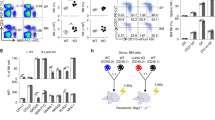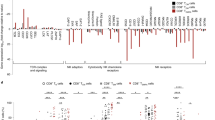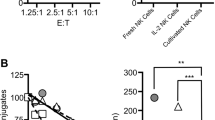Abstract
CRACC is a self-associating member of the signaling lymphocytic activation molecule family that is expressed on cells of the immune system, including natural killer cells and activated T cells. Here we examine the function and mechanism of action of CRACC using several complementary approaches, including the generation of a CRACC-deficient mouse. Our results demonstrate that CRACC positively regulated natural killer cell functions by a mechanism dependent on the adaptor EAT-2 but not the related adaptor SAP. However, in the absence of EAT-2, CRACC potently inhibited natural killer cell function. CRACC was also inhibitory in T cells, which are typically devoid of EAT-2. Thus, CRACC can exert activating or inhibitory influences on cells of the immune system depending on cellular context and the availability of effector proteins.
This is a preview of subscription content, access via your institution
Access options
Subscribe to this journal
Receive 12 print issues and online access
$209.00 per year
only $17.42 per issue
Buy this article
- Purchase on Springer Link
- Instant access to full article PDF
Prices may be subject to local taxes which are calculated during checkout








Similar content being viewed by others
References
Lanier, L.L. NK cell recognition. Annu. Rev. Immunol. 23, 225–274 (2005).
Vivier, E., Nunes, J.A. & Vely, F. Natural killer cell signaling pathways. Science 306, 1517–1519 (2004).
Raulet, D.H. Roles of the NKG2D immunoreceptor and its ligands. Nat. Rev. Immunol. 3, 781–790 (2003).
Ma, C.S., Nichols, K.E. & Tangye, S.G. Regulation of cellular and humoral immune responses by the SLAM and SAP families of molecules. Annu. Rev. Immunol. 25, 337–379 (2007).
Veillette, A., Dong, Z. & Latour, S. Consequence of the SLAM-SAP signaling pathway in innate-like and conventional lymphocytes. Immunity 27, 698–710 (2007).
Veillette, A. NK cell regulation by SLAM family receptors and SAP-related adapters. Immunol. Rev. 214, 22–34 (2006).
Engel, P., Eck, M.J. & Terhorst, C. The SAP and SLAM families in immune responses and X-linked lymphoproliferative disease. Nat. Rev. Immunol. 3, 813–821 (2003).
Mathew, P.A. et al. Cloning and characterization of the 2B4 gene encoding a molecule associated with non-MHC-restricted killing mediated by activated natural killer cells and T cells. J. Immunol. 151, 5328–5337 (1993).
Bottino, C. et al. NTB-A, a novel SH2D1A-associated surface molecule contributing to the inability of natural killer cells to kill Epstein-Barr virus-infected B cells in X-linked lymphoproliferative disease. J. Exp. Med. 194, 235–246 (2001).
Zhong, M.C. & Veillette, A. Control of T lymphocyte signaling by Ly108, a signaling lymphocytic activation molecule family receptor implicated in autoimmunity. J. Biol. Chem. 283, 19255–19264 (2008).
Aoukaty, A. & Tan, R. Association of the X-linked lymphoproliferative disease gene product SAP/SH2D1A with 2B4, a natural killer cell-activating molecule, is dependent on phosphoinositide 3-kinase. J. Biol. Chem. 277, 13331–13337 (2002).
Tangye, S.G., Phillips, J.H., Lanier, L.L. & Nichols, K.E. Functional requirement for SAP in 2B4-mediated activation of human natural killer cells as revealed by the X-linked lymphoproliferative syndrome. J. Immunol. 165, 2932–2936 (2000).
Nakajima, H. et al. Patients with X-linked lymphoproliferative disease have a defect in 2B4 receptor-mediated NK cell cytotoxicity. Eur. J. Immunol. 30, 3309–3318 (2000).
Bloch-Queyrat, C. et al. Regulation of natural cytotoxicity by the adaptor SAP and the Src-related kinase Fyn. J. Exp. Med. 202, 181–192 (2005).
Lee, K.M. et al. 2B4 acts as a non-major histocompatibility complex binding inhibitory receptor on mouse natural killer cells. J. Exp. Med. 199, 1245–1254 (2004).
Bouchon, A., Cella, M., Grierson, H.L., Cohen, J.I. & Colonna, M. Cutting edge: activation of NK cell-mediated cytotoxicity by a SAP-independent receptor of the CD2 family. J. Immunol. 167, 5517–5521 (2001).
Hsi, E.D. et al. CS1, a potential new therapeutic antibody target for the treatment of multiple myeloma. Clin. Cancer Res. 14, 2775–2784 (2008).
Tai, Y.T. et al. Anti-CS1 humanized monoclonal antibody HuLuc63 inhibits myeloma cell adhesion and induces antibody-dependent cellular cytotoxicity in the bone marrow milieu. Blood 112, 1329–1337 (2007).
Stark, S. & Watzl, C. 2B4 (CD244), NTB-A and CRACC (CS1) stimulate cytotoxicity but no proliferation in human NK cells. Int. Immunol. 18, 241–247 (2006).
Kumaresan, P., Lai, W., Chuang, S., Bennett, M. & Mathew, P. CS1, a novel member of the CD2 family, is homophilic and regulates NK cell function. Mol. Immunol. 39, 1–8 (2002).
Boles, K.S., Stepp, S.E., Bennett, M., Kumar, V. & Mathew, P.A. 2B4 (CD244) and CS1: novel members of the CD2 subset of the immunoglobulin superfamily molecules expressed on natural killer cells and other leukocytes. Immunol. Rev. 181, 234–249 (2001).
Tassi, I. & Colonna, M. The cytotoxicity receptor CRACC (CS-1) recruits EAT-2 and activates the PI3K and phospholipase Cgamma signaling pathways in human NK cells. J. Immunol. 175, 7996–8002 (2005).
Diefenbach, A., Jensen, E.R., Jamieson, A.M. & Raulet, D.H. Rae1 and H60 ligands of the NKG2D receptor stimulate tumour immunity. Nature 413, 165–171 (2001).
Veillette, A., Cruz-Munoz, M.E. & Zhong, M.C. SLAM family receptors and SAP-related adaptors: matters arising. Trends Immunol. 27, 228–234 (2006).
Griewank, K. et al. Homotypic interactions mediated by Slamf1 and Slamf6 receptors control NKT cell lineage development. Immunity 27, 751–762 (2007).
Li, W. et al. The SLAM-associated protein signaling pathway is required for development of CD4+ T cells selected by homotypic thymocyte interaction. Immunity 27, 763–774 (2007).
Lee, K.M. et al. Requirement of homotypic NK cell interactions through 2B4(CD244)/CD48 in the generation of NK effector functions. Blood 107, 3181–3188 (2006).
Roncagalli, R. et al. Negative regulation of natural killer cell function by EAT-2, a SAP-related adaptor. Nat. Immunol. 6, 1002–1010 (2005).
Latour, S. et al. Regulation of SLAM-mediated signal transduction by SAP, the X-linked lymphoproliferative gene product. Nat. Immunol. 2, 681–690 (2001).
Latour, S. et al. Binding of SAP SH2 domain to FynT SH3 domain reveals a novel mechanism of receptor signalling in immune regulation. Nat. Cell Biol. 5, 149–154 (2003).
Chan, B. et al. SAP couples Fyn to SLAM immune receptors. Nat. Cell Biol. 5, 155–160 (2003).
Tovar, V. et al. Mouse novel Ly9: a new member of the expanding CD150 (SLAM) family of leukocyte cell-surface receptors. Immunogenetics 54, 394–402 (2002).
Sidorenko, S.P. & Clark, E.A. The dual-function CD150 receptor subfamily: the viral attraction. Nat. Immunol. 4, 19–24 (2003).
Sayos, J. et al. The X-linked lymphoproliferative-disease gene product SAP regulates signals induced through the co-receptor SLAM. Nature 395, 462–469 (1998).
Li, C., Iosef, C., Jia, C.Y., Han, V.K. & Li, S.S. Dual functional roles for the X-linked lymphoproliferative syndrome gene product SAP/SH2D1A in signaling through the signaling lymphocyte activation molecule (SLAM) family of immune receptors. J. Biol. Chem. 278, 3852–3859 (2003).
Vaidya, S.V. et al. Targeted disruption of the 2B4 gene in mice reveals an in vivo role of 2B4 (CD244) in the rejection of B16 melanoma cells. J. Immunol. 174, 800–807 (2005).
Sivori, S. et al. Early expression of triggering receptors and regulatory role of 2B4 in human natural killer cell precursors undergoing in vitro differentiation. Proc. Natl. Acad. Sci. USA 99, 4526–4531 (2002).
Parolini, S. et al. X-linked lymphoproliferative disease. 2B4 molecules displaying inhibitory rather than activating function are responsible for the inability of natural killer cells to kill Epstein-Barr virus-infected cells. J. Exp. Med. 192, 337–346 (2000).
Lanier, L.L. NK cell receptors. Annu. Rev. Immunol. 16, 359–393 (1998).
Veillette, A. et al. SAP expression in T cells, not in B cells, is required for humoral immunity. Proc. Natl. Acad. Sci. USA 105, 1273–1278 (2008).
Kaye, J. et al. Selective development of CD4+ T cells in transgenic mice expressing a class II MHC-restricted antigen receptor. Nature 341, 746–749 (1989).
Habu, S. et al. In vivo effects of anti-asialo GM1. I. Reduction of NK activity and enhancement of transplanted tumor growth in nude mice. J. Immunol. 127, 34–38 (1981).
Acknowledgements
We thank S. Latour for critical reading of the manuscript; J. Drouin (Clinical Research Institute of Montreal) for pJA1617; and J. Penninger (Institute for Molecular Biotechnology) for pCAGGS-Flpe. Supported by the Canadian Institutes of Health Research (A.V. and Z.D.), the Canadian Cancer Society (A.V. and M.-E.C.-M.), the Howard Hughes Medical Institute (A.V.), the Cancer Research Society (M.-E.C.-M.), the Canada Research Chair Program (A.V.), the Clinical Research Institute of Montreal (Z.D.) and the Terry Fox Foundation (M.-E.C.-M.).
Author information
Authors and Affiliations
Contributions
M.-E.C.-M. conceived research, did experiments, analyzed data and wrote the manuscript; Z.D. conceived research, did experiments and generated critical reagents; X.S. and S.Z. did research and generated critical reagents; and A.V. conceived research, analyzed data and wrote the manuscript.
Corresponding author
Supplementary information
Supplementary Text and Figures
Supplementary Figures 1–6 and Methods (PDF 2343 kb)
Rights and permissions
About this article
Cite this article
Cruz-Munoz, ME., Dong, Z., Shi, X. et al. Influence of CRACC, a SLAM family receptor coupled to the adaptor EAT-2, on natural killer cell function. Nat Immunol 10, 297–305 (2009). https://doi.org/10.1038/ni.1693
Received:
Accepted:
Published:
Issue Date:
DOI: https://doi.org/10.1038/ni.1693
This article is cited by
-
Innate lymphoid cells and innate-like T cells in cancer — at the crossroads of innate and adaptive immunity
Nature Reviews Cancer (2023)
-
Macrophage-mediated anti-tumor immunity against high-risk neuroblastoma
Genes & Immunity (2022)
-
CS1 CAR-T targeting the distal domain of CS1 (SLAMF7) shows efficacy in high tumor burden myeloma model despite fratricide of CD8+CS1 expressing CAR-T cells
Leukemia (2022)
-
Plasma membrane lipid scrambling causing phosphatidylserine exposure negatively regulates NK cell activation
Cellular & Molecular Immunology (2021)
-
Selective elimination of immunosuppressive T cells in patients with multiple myeloma
Leukemia (2021)



